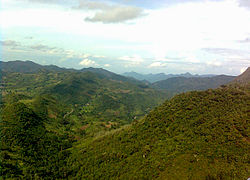Araku Valley
|
Araku Valley అరకు లోయ |
|
|---|---|
| Hill Station | |

Araku Valley Scenic View
|
|
| Coordinates: 18°20′00″N 82°52′00″E / 18.3333°N 82.8667°ECoordinates: 18°20′00″N 82°52′00″E / 18.3333°N 82.8667°E | |
| Country | India |
| State | Andhra Pradesh |
| District | Visakhapatnam |
| Elevation | 910 m (2,990 ft) |
| Languages | |
| • Official | Telugu |
| Time zone | IST (UTC+5:30) |
| PIN | 531 149 |
| Telephone code | 08936 |
| Vehicle registration | AP |
Araku Valley is a Hill station in Visakhapatnam district in the state of Andhra Pradesh in India. It is a valley in the Eastern Ghats inhabited by different tribes.
Araku is located at 18°20′00″N 82°52′00″E / 18.3333°N 82.8667°E. It has an average elevation of 911 metres (2,989 ft).
It is located 114 km from Visakhapatnam, close to the Odisha state border. The Anantagiri and Sunkarimetta Reserved Forest which are part of Araku Valley, are rich in biodiversity. This valley is surrounded by mountains like Galikonda, Raktakonda, Sunkarimetta and Chitamogondi. These hills are endowed with rich quality bauxite ore. Galikonda hill rising to a height of 5,000 feet (1,500 m) is one of the highest in Andhra Pradesh. The average rainfall is 1700 mm, bulk of which is received during June–October.
Coffee was first introduced in Eastern Ghats of Andhra Pradesh in 1898 by Mr. Brodi, a Brtisher in Pamuleru valley in East Godavari district. Subsequently, it spread over to Pullangi (East Godavari district) and Araku Valley,Gudem of Visakhapatnam agency tracks. In 1920s even though it spread over to Ananthagiri in Araku valley and Chintapalli areas, coffee cultivation remained dormant for a long time. In 1960s, the Andhra Pradesh Forest Department developed coffee plantations in 10100 acres in Reserve forest areas. These plantations were handed over to the A.P. Forest Development Corporation in the year 1985. In the year 1956 after the formation of Andhra Pradesh Girijan Cooperative Corporation Limited (GCC), the Coffee Board identified GCC for promoting coffee plantations. Since then GCC started making efforts to develop coffee plantation through local tribal famers. A separate coffee wing was carved out in GCC and promoting coffee in around 4000 hectares taken up.
...
Wikipedia

